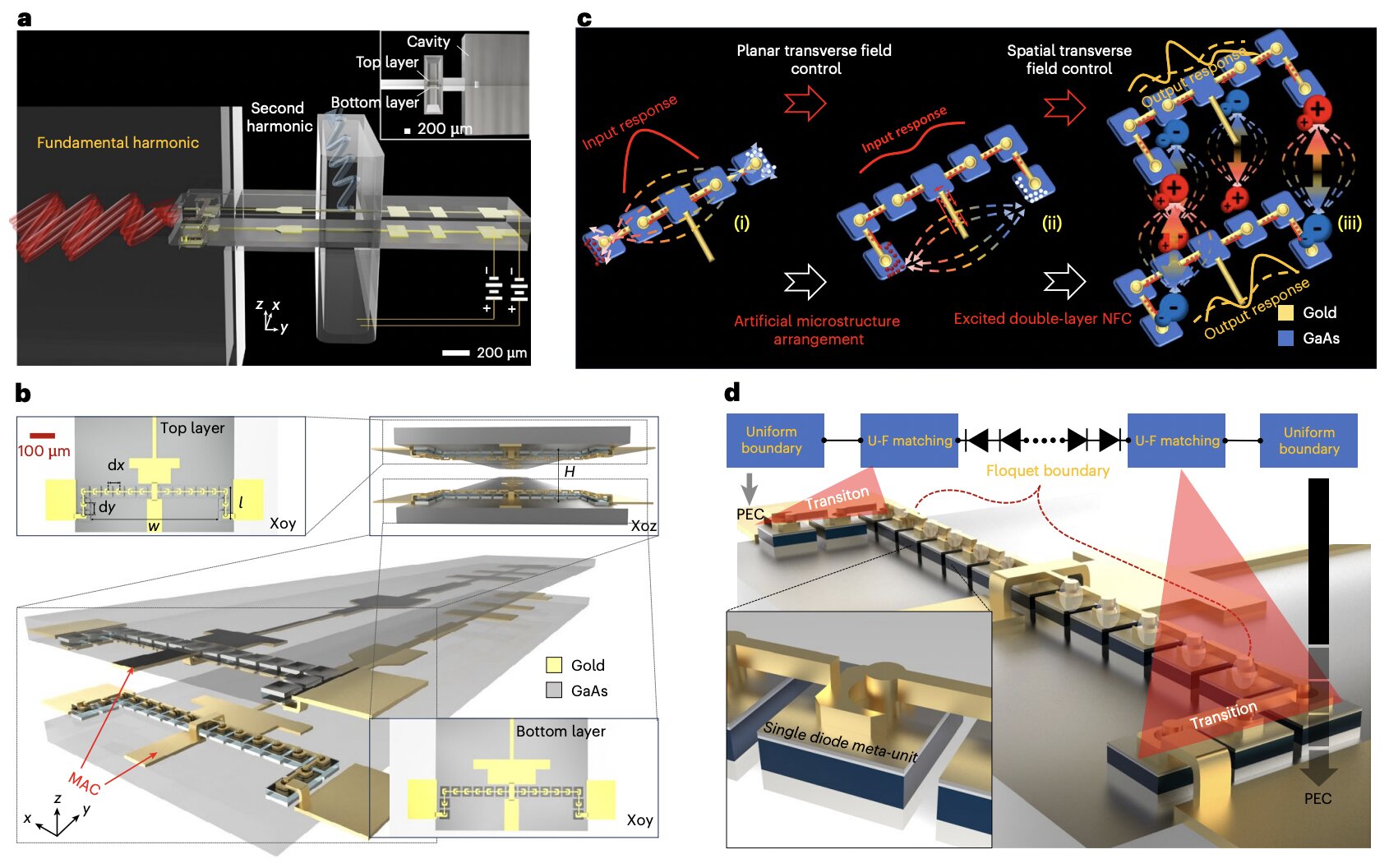Tech
New diode chain could be used to develop high-power terahertz technologies

Electromagnetic waves with frequencies between microwave and infrared light, also known as terahertz radiation, are leveraged by many existing technologies, including various imaging tools and wireless communication systems. Despite their widespread use, generating strong and continuous terahertz signals using existing electronics is known to be challenging.
To reliably generate terahertz signals, engineers often rely on frequency multipliers, electronic circuits that can distort an input signal, to generate an output signal with a desired frequency. Some of these circuits are based on Schottky barrier diodes, devices in which the junction between a metal and semiconductor form a one-way electrical contact.
While some frequency multipliers based on Schottky barrier diodes have achieved promising results, devices based on individual diodes can only handle a limited amount of energy. To increase the energy they can manage, engineers can use several diodes arranged in a chain. However, even this approach can have its limitations, as the distribution of the electromagnetic field between the diodes in a chain often becomes uneven.
Researchers at University of Electronic Science and Technology recently introduced a new diode chain design that could overcome this limitation, by reshaping local electromagnetic fields and distributing them more uniformly along the chain. The new asymmetric C-shaped diode chain, introduced in a paper published in Nature Electronics, was found to multiply frequencies more efficiently than most other diode-based frequency multipliers developed to date.
“Frequency multiplier devices based on Schottky barrier diodes can be used to generate terahertz radiation, offering high power output and potential integration into all-solid-state systems,” wrote Honji Zhou, Tianchi Zhou and their colleagues in their paper.
“However, the scaling of the output power of such devices is often limited by the power handling capacity of a single diode. A connected chain of Schottky barrier diodes, together with a power combining approach, can be used to increase the terahertz output power. Yet the uneven field distribution among the diodes—which is related to the similarity between the terahertz wavelength and the physical dimensions of the diodes themselves—leads to lower efficiency and premature breakdown.”
To overcome the limitations of previously introduced single diode-based and diode chain-based frequency amplifiers, the researchers introduced a new design in which diodes are arranged in a double-layer chain shaped like the letter C. The shape of the chain is asymmetric, as this can improve the flow of electromagnetic fields between diodes.
The researchers assessed the performance of their newly designed diode chain in both simulations and laboratory tests. Remarkably, they found that it achieved one of the highest terahertz frequency-doubling efficiencies reported to date, highlighting its potential as a frequency multiplier.
“We report an asymmetric double-layer C-shaped diode chain structure that can adjust the local electromagnetic field distribution and enhance the conversion efficiency of the diode chain,” wrote the authors. “Our resulting device has a frequency doubling efficiency of 38%, with an output exceeding 300 mW at 170 GHz.”
The C-shaped diode chain could soon be improved and used to develop a wide range of electronic devices. In the future, it could enable the introduction of more compact terahertz wave transmitters and generators, which could be used to create more advanced imaging, sensing and communication systems.
Written for you by our author Ingrid Fadelli, edited by Gaby Clark, and fact-checked and reviewed by Robert Egan—this article is the result of careful human work. We rely on readers like you to keep independent science journalism alive.
If this reporting matters to you,
please consider a donation (especially monthly).
You’ll get an ad-free account as a thank-you.
More information:
Hongji Zhou et al, A terahertz nonlinear diode chain based on an asymmetric double-layer topology, Nature Electronics (2025). DOI: 10.1038/s41928-025-01460-9.
© 2025 Science X Network
Citation:
New diode chain could be used to develop high-power terahertz technologies (2025, October 31)
retrieved 31 October 2025
from https://techxplore.com/news/2025-10-diode-chain-high-power-terahertz.html
This document is subject to copyright. Apart from any fair dealing for the purpose of private study or research, no
part may be reproduced without the written permission. The content is provided for information purposes only.
Tech
Meet the Linen Sheets That Will Last You a Lifetime

Comparing Our Favorite Linen Sheets
Honorable Mentions
Not all sheets are created equal. The linens below are good but not as great as our picks above.
Avocado Natural Linen Sheets for $549: These were our previous organic pick, but they’re no longer GOTS-certified or marked organic by Avocado. These are still great, heavyweight linen sheets, and still have an Oeko-Tex certification to confirm no toxic materials were used during production.
Brooklinen Washed Linen Core Set for $359: This is the updated version of these linen sheets, but they feel similarly to the previous edition; a little itchy at the start compared to our other picks, and felt a little warm to sleep on too. They’re solid linen sheets, and often have new colors available (seasonal colorways do sell out fast) but all of our picks are softer, and some are cheaper, too.
Buffy Belgian Linen Sheet Set for $279: These sheets feel rough if you touch them with just your hand or sit on the sheets, but lying down entirely on these, they felt much more comfortable. These are solid, breathable linen sheets with flax sourced from Belgium. Both my husband and I had insane dreams the week we slept on these sheets, so if you’re looking for more fun dreams, give these affordable linen sheets a whirl.
Company Store Legends Hotel Washed Linen Sheet Set for $357: If you’re looking for something with a little more heft but don’t want to drop $500+, then The Company Store’s Legends Hotel Washed Linen Sheets sit nicely in the middle of price and weight. These sheets have a little more weight than The Citizenry and Pottery Barn, but don’t feel as heavy as Cultiver and Rough Linen. Many colors and sizes are currently out of stock, though.
Cozy Earth Linen Duvet Cover for $288: This cover has a great softness to it and feels ideal for summertime, but the zipper on my set broke almost immediately. It could just be bad luck, since we usually love Cozy Earth’s home goods.
Ikea Dytag Duvet Cover: My favorite linen duvet cover and pillowcase set from Ikea has been replaced with a few different cheaper lines, including the Angslilja ($40) and Strandlummer ($65). My Dytag lasted me a few years, though cheaper linen sets might not last as long as that set did.
Naturepedic Organic Linen Fitted Sheet & Pillowcases Set for $305: This set is heavy, but still manages to be really breathable; it was downright chilly to sleep on alone in the winter. It’s also a rare organic set, with GOTS-certified organic flax used. There’s no top sheet available right now, but you can get a fitted sheet and two pillowcases together, or separately.
Rough Linen Orkney Sheets for $498: WIRED reviewer Scott Gilbertson loves these super heavyweight linen sheets, and says they’re best for confirmed linen lovers with how heavy and rough they are. They’re completely sold out, otherwise they’d be a pick in the guide. We’ll reinstate them once they’re back in stock.
Rough Linen Smooth Linen Sheets for $498: These linen sheets live up to the name with a silky, smooth feel, like a linen twist on sateen. They were a little heavy for my liking, but if that’s up your alley, it’s a beautiful set of sheets that will last.
Slumber Cloud Performance Linen Blend for $329: This is a blend set that uses Slumber Cloud’s patented Outlast fiber, which is part of what makes the brand’s cooling Tencel lyocell sheets so good. These linen blend sheets were soft to the touch, but didn’t pack as cooling of an experience compared to regular linen and Slumber Cloud’s other sheets.
Thuma Flax Linen Sheet Set for $315: These linen sheets from the famed Thuma were solid all-around linen, keeping me nice and cool. (So cool that they’re a pick in our cooling sheets guide.) They also had a good weight and structure to them. They’re not quite as soft as our picks above, but were still a little softer than other options like Brooklinen.
FAQs
What’s So Great About Linen?
Linen is a woven fabric made from flax plants. It’s a highly breathable material that doesn’t trap heat, so it keeps you cool during warmer nights. It’s great for people who sleep hot. It’s rougher at first than a simple cotton sheet set, but it should soften up the more it’s washed. Linen is often more expensive than other sheets, but it’s generally more durable than percale or other cotton weaves, so a good sheet set should last a long time.
It does tend to be more expensive since flax is more time-consuming to harvest and process into sheets, but high-quality linen should last you for years to come, making it an investment in both staying cool (which is very important for sleep quality) but also in gorgeous bedding you can enjoy for years. The structure of linen always lends a nice-styled look to even the messiest of beds, too. I love sleeping on linen so long as it isn’t too scratchy, which is one of the many things I looked for while testing and searching for the best linen sheets.
It’s not for everyone, but if you love linen apparel, you’ll probably love linen sheets. If you’re unsure, start with a single piece (like a duvet or flat sheet) and see what you think. Most of the options we recommend come in a linen set, but you can also buy many of these pieces separately, allowing you to try a linen pillowcase or fitted sheet before wading into a full-on linen bed.
You’ll often see terms like “Belgian flax” and “European linen” used to describe various linens. Some of these are in the name, some aren’t—Pottery Barn’s sheets are named Belgian flax, while The Citizenry’s sheets mention that they’re French flax but sustainably made in Portugal. So what does it all mean? Which is best?
Europe has a long history of growing flax and making linen. It’s a preferred source, particularly Belgium and France, which is why some sheets will call out those countries specifically. But according to World Linen, there isn’t a huge difference among European countries—it’s mostly a marketing tactic. You’ll likely be just as happy with any European source of linen, and there is a European Linen certification sheets can receive to confirm that’s where they’re sourced from.
Having Europe in the name doesn’t necessarily mean it was made there, though. After the flax is grown, it needs to be processed, spun, and woven into sheets, which may or may not happen in Europe. Some companies use the term “Belgian flax” or “European flax” to signify that the flax is from that area, but it wasn’t processed there. Some companies make sheets in other European countries, like The Citizenry’s Portugal-made sheets, while other makers might do production outside of Europe, like Quince, which processes its sheets in China and India.
Does Linen Use Thread Count?
You won’t usually see thread counts listed for linen sheets, or even if you do, there’s another term you’ll find along side it: GSM, or a phrase like “woven to 160 GSM.” This describes the weight of the fabric. (“GSM” stands for grams per square meter.) It’s similar to silk, which is also described in weight rather than thread count to give you a more accurate idea of how heavy the sheets will be. The rule of thumb with linen is that under 150 GSM is light, between 150 and 300 is medium, and anything over 300 is heavy.
Weight is also something that shouldn’t change about linen: It’ll get softer over time, but it won’t get lighter. If you have a preference for a certain weight of sheets, you can see whether these details are included to find out exactly what you’re buying.
How Do You Wash Linen Sheets?
If you want your linen to last for years, you have to take care of it. Our preferred way is to wash with cold water and mild detergent. Line-drying is recommended for getting the longest life. Be sure to check the tag, since some makers might have specific washing instructions. You should wash any sheets you buy before you sleep on them, and washing linen will start to soften them up—remember, it takes a while for softening to happen!
I actually break one of these rules. Since I don’t have space for a drying line, I tumble dry all of my linen, and I’ve done so for years with fine results. But if you use a dryer, expect to clean up a lot of lint. With every set I’ve tried, the lint tray gets super full, and some sheets like Quince’s filled the lint trap so much that it started to overflow.
How Do We Test Linen Sheets?
We test sheets by—you guessed it—sleeping on them. We test all bed sheets for a minimum of two nights, often ending up closer to seven nights or more for our top picks. We look for breathability, airflow, and the weight of the sheets, and we research where each maker sources their linen from and where it’s produced (which can impact both the quality and the price point). We’ve tested a little over a dozen different linen sheets so far for this guide.
While the best way to care for linen is to line dry it, we wash and dry linen sheets in regular machines to see how they hold up (and if the lint tray overflows!) and wash them a couple of times before including them in a guide.
Power up with unlimited access to WIRED. Get best-in-class reporting and exclusive subscriber content that’s too important to ignore. Subscribe Today.
Tech
Opposed to Data Centers? The Working Families Party Wants You to Run for Office

The Working Families Party said Thursday that it is putting out a specific recruitment call for people who are organizing against data centers in their communities to run for office.
The announcement comes amid a period of heightened political turmoil around data centers, as some high-profile Democrats wade into the fight. Earlier this week, three Democrats in the Senate sent letters seeking information from Big Tech companies about how data centers impact electricity bills, while senator Bernie Sanders, the independent from Vermont, became the first national politician to call for a moratorium on data center construction.
“We see our role as responding to what working families and working people are concerned about, what issues are keeping them up at night,” says Ravi Mangla, the national press secretary for the Working Families Party. “We would be ignoring the needs of our constituents if we were not responding to the issue of data centers and their impacts on communities.”
The Working Families Party was originally founded in New York in the late 1990s; it now has chapters in states across the country. While it (mostly) doesn’t seat candidates independently, the progressive third party’s endorsements and organizing power can carry real weight in the races where it chooses to get involved. It endorsed Zohran Mamdani in New York’s mayoral race this year, as well as a string of other successful candidates.
Opposition to data centers has skyrocketed in some areas of the country over the past year, as tech companies have ramped up their investment in building out hundreds of facilities across the country. Polling from the outlet Heatmap released in September shows that less than half of Americans of all political persuasions would welcome a data center being built near where they live, while a recent survey from a private industry group shows that community opposition increased in the second quarter of this year, successfully stalling or stopping billions of dollars in data center development.
In many regions of the country, affordability issues—including rising electricity bills—are becoming tangled with other concerns around data centers, like worries over the climate and water impacts, or even noise from the centers themselves. Concern over data centers played a role in a number of midterm elections, including factoring into several races in Virginia, which has the highest concentration of data centers in the country and is facing rising demands for energy from more facilities projected to come online through the end of the decade. The political ripple around data centers has lasted beyond the midterms—and stretched beyond just Virginia. In the past week, officials in Chandler, Arizona voted 7-0 to reject a proposed data center in the city, despite high-profile lobbying from former senator Kyrsten Sinema, while voters in Georgia on Tuesday elected a newcomer to the state legislature who has promised legislation to make data centers “pay their fair share.”
Mangla says the Working Families Party decided to launch the recruitment effort after seeing how the issue played out in Virginia’s elections, and after observing some of the intense local pushback around the country. “You can’t fill a community center or a town hall just organically,” he says. “There are people who are clearly stepping up in their communities, organizing their neighbors, and leading the charge to push back against these data centers.”
Tech
A Filmmaker Made a Sam Altman Deepfake—and Got Unexpectedly Attached

Director Adam Bhala Lough didn’t set out to make a documentary about a digital simulacrum of Sam Altman.
But after about 100 days of texting and emailing the OpenAI CEO for an interview—with no response, he claims, and with financiers hounding him to make good on his original pitch—Lough was at his wit’s end.
He’d exhausted just about every angle. “Once I reached that point, I gave up and I pivoted to gate-crashing OpenAI,” he says. Though he’d employed a similar tactic in his Emmy-nominated 2023 documentary Telemarketers—a chronicle of industry-wide corruption in the telemarketing business—it wasn’t a filmmaking style he felt all that comfortable with. “It was a fortress. I was able to slip through the gate, and immediately security grabbed me and physically removed me from the premises.”
So begins Deepfaking Sam Altman, Lough’s portrait of how AI is reshaping society and his quest to talk to the man behind it. When his original plan fell through he drew inspiration from Altman himself. “The Scarlett Johansson controversy erupted,” he says. In 2024, the actress publicly called out OpenAI for seeming to copy her voice for its new AI voice assistant Sky. “It was at that point where I got the idea to do the deepfake.” (In a May 2024 statement, Altman apologized to Johansson and said Sky’s voice was “never intended to resemble” hers.)
What originally starts out as a simple voice clone balloons into a full deepfake of Altman called Sam Bot, which Lough travels to India to have created. This being a Lough film, though, nothing goes according to plan. Without spoiling too much, Sam Bot eventually becomes its own entity, and the film takes an even stranger—and revelatory—dive from there. “There’s parallels between this movie and Terminator 2: Judgement Day, but there’s none of the violence,” he says. Lough grew up during what he calls the “AI 1.0 era.” His obsession with James Cameron’s Terminator 2 was a major influence on his craft.
Deepfaking Sam Altman, which is based partially on the New York Magazine story casting Sam Altman as the Oppenheimer of our age, features commentary from former OpenAI safety engineer Heidy Khlaaf, who tells Lough, “We’re starting to see OpenAI dip its toes in military uses, and I cannot imagine something like Dall-E and ChatGPT being used for military assists. That really scares me, given how inaccurate those systems are.”
-

 Business5 days ago
Business5 days agoHitting The ‘High Notes’ In Ties: Nepal Set To Lift Ban On Indian Bills Above ₹100
-

 Politics1 week ago
Politics1 week agoTrump launches gold card programme for expedited visas with a $1m price tag
-

 Business1 week ago
Business1 week agoRivian turns to AI, autonomy to woo investors as EV sales stall
-

 Sports1 week ago
Sports1 week agoPolice detain Michigan head football coach Sherrone Moore after firing, salacious details emerge: report
-

 Fashion1 week ago
Fashion1 week agoTommy Hilfiger appoints Sergio Pérez as global menswear ambassador
-

 Business1 week ago
Business1 week agoCoca-Cola taps COO Henrique Braun to replace James Quincey as CEO in 2026
-

 Sports1 week ago
Sports1 week agoU.S. House passes bill to combat stadium drones
-

 Tech1 week ago
Tech1 week agoGoogle DeepMind partners with UK government to deliver AI | Computer Weekly

















